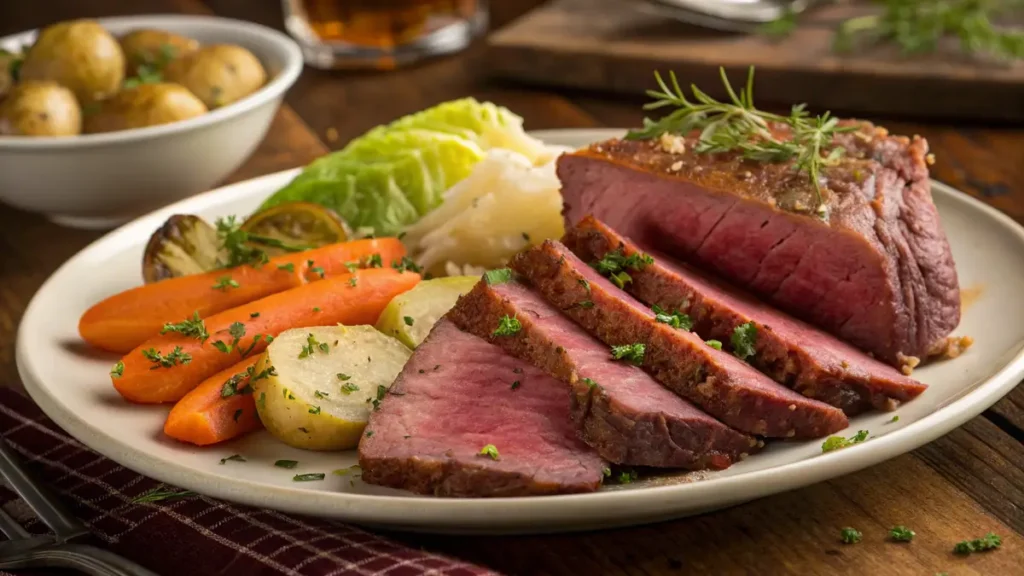Corned beef is a timeless dish that brings warmth and flavor to any table. Its rich, savory taste and tender texture make it a favorite for family dinners, festive gatherings, and even casual meals. While store-bought options are convenient, making it at home allows you to tailor the flavors to your liking and enjoy a fresher, more satisfying result. In this guide, we’ll explore everything you need to know about making corned beef from scratch, from its benefits and ingredients to step-by-step instructions, serving ideas, and storage tips.
____________________
Table of Contents
____________________
Key Benefits of Corned Beef
Corned beef isn’t just a delicious dish—it’s also packed with benefits that make it worth the effort. Here’s why you should consider making it at home:
- Nutritional Value: Corned beef is a great source of protein, iron, and vitamin B12, which are essential for energy and overall health. By making it yourself, you can control the ingredients and create a healthier version, For more detailed nutritional information, refer to the USDA FoodData Central database : corned beef
- Tender Texture: The brining process breaks down the meat fibers, resulting in a juicy, melt-in-your-mouth texture that’s hard to beat.
- Customizable Flavors: When you prepare it at home, you can experiment with spices and seasonings to create a flavor profile that suits your taste.
- Cost-Effective: Homemade versions are often more economical than store-bought options, especially when feeding a crowd.
- A Connection to Tradition: This dish has a rich history, and making it at home allows you to connect with culinary traditions while creating new memories.
Ingredients for Homemade Corned Beef: A Detailed Breakdown
Creating corned beef at home starts with gathering the right ingredients. Each component plays a crucial role in flavoring, tenderizing, and preserving the meat. Here’s a detailed look at what you’ll need and why each ingredient matters:

1. Beef Brisket
- Why It’s Important: The star of the dish, beef brisket is a tough cut of meat that becomes tender and flavorful through the brining and slow-cooking process. Its marbling (fat content) adds richness and juiciness to the final dish.
- What to Look For: Choose a brisket that’s well-marbled with fat, as this ensures a moist and tender result. A 3 to 5-pound brisket is ideal for most recipes.
- Pro Tip: If you can’t find brisket, you can use other cuts like round or rump roast, but keep in mind they may be leaner and less tender.
2. Kosher Salt
- Why It’s Important: Salt is the backbone of the brine. It not only seasons the meat but also helps preserve it by drawing out moisture and inhibiting bacterial growth.
- What to Look For: Use kosher salt or coarse sea salt. Avoid table salt, as it’s finer and can make the meat overly salty.
- Pro Tip: If you’re watching your sodium intake, you can reduce the amount of salt slightly, but keep in mind it may affect the curing process.
3. Sugar
- Why It’s Important: Sugar balances the saltiness of the brine and adds a subtle sweetness to the meat. It also helps tenderize the brisket by breaking down proteins.
- What to Look For: Brown sugar is a popular choice because it adds a hint of molasses flavor. However, white sugar or even honey can be used as alternatives.
- Pro Tip: For a deeper flavor, try using dark brown sugar or a combination of sugar and honey.
4. Pickling Spices
- Why It’s Important: Pickling spices are the heart of the brine’s flavor. They infuse the meat with a complex, aromatic taste that defines corned beef.
- What’s in Pickling Spices: A typical blend includes:
- Coriander Seeds: Earthy and citrusy.
- Mustard Seeds: Slightly spicy and tangy.
- Allspice Berries: Warm and slightly sweet.
- Bay Leaves: Earthy and aromatic.
- Black Peppercorns: Adds a mild heat.
- What to Look For: You can buy pre-made pickling spice blends or make your own by combining the spices listed above.
- Pro Tip: Experiment with additional spices like cloves, cinnamon, or red pepper flakes for a unique twist.
5. Garlic
- Why It’s Important: Garlic adds a robust, savory flavor to the brine. It complements the spices and enhances the overall taste of the meat.
- What to Look For: Use fresh garlic cloves for the best flavor. Pre-minced garlic can work in a pinch, but fresh is always better.
- Pro Tip: Crush the garlic cloves slightly before adding them to the brine to release their flavor.
6. Bay Leaves
- Why It’s Important: Bay leaves add a subtle, earthy aroma to the brine. They enhance the complexity of the flavor without overpowering the other spices.
- What to Look For: Use dried bay leaves, which are readily available in most grocery stores.
- Pro Tip: If you have fresh bay leaves, use two for every one dried leaf, as fresh leaves are less potent.
7. Water
- Why It’s Important: Water is the base of the brine. It dissolves the salt, sugar, and spices, allowing them to penetrate the meat.
- What to Look For: Use filtered or distilled water if possible, as tap water can sometimes have off-flavors that affect the final dish.
- Pro Tip: Make sure the water fully covers the brisket during brining to ensure even curing.
Optional Ingredients for Added Flavor
If you want to take your corned beef to the next level, consider adding these optional ingredients to the brine or cooking liquid:
- Beer or Stout: Adds depth and richness to the flavor.
- Apple Cider Vinegar: Provides a tangy note that balances the richness of the meat.
- Onions: Adds sweetness and complexity to the brine.
- Carrots and Celery: Enhance the aromatic profile of the cooking liquid.
Ingredient Ratios for the Brine
Here’s a simple ratio to follow for the brine:
- 1 gallon of water
- 1 cup kosher salt
- ½ cup sugar
- 2 tablespoons pickling spices
- 4 garlic cloves, crushed
- 2 bay leaves
This ratio works well for a 3 to 5-pound brisket. Adjust the quantities if you’re working with a larger or smaller cut of meat.
How to Make Corned Beef: A Step-by-Step Guide
Making corned beef at home is a rewarding process that involves brining and slow-cooking a beef brisket to perfection. Here’s a detailed guide to help you through each step:
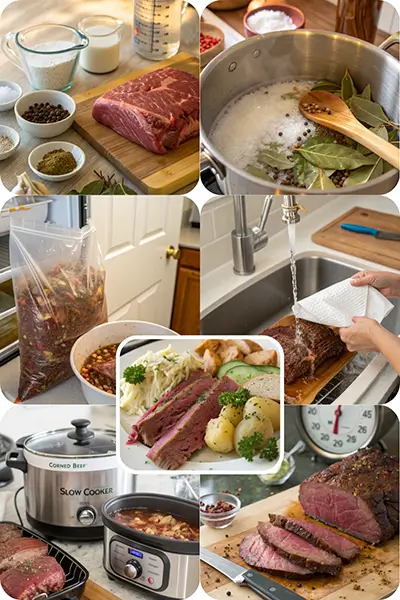
Step 1: Gather Your Ingredients
Before you begin, make sure you have all the necessary ingredients on hand. Here’s what you’ll need:
- Beef Brisket: A 3 to 5-pound cut, preferably with a good layer of fat for added flavor and tenderness.
- Kosher Salt: Essential for the brine. Avoid table salt, as it can make the meat too salty.
- Sugar: Balances the saltiness and enhances the flavor. Brown sugar works particularly well.
- Pickling Spices: A blend of coriander seeds, mustard seeds, allspice berries, and bay leaves. You can buy pre-made pickling spice or make your own.
- Garlic: Fresh cloves add depth to the brine.
- Water: Enough to fully submerge the brisket.
Step 2: Prepare the Brine
The brine is the key to flavorful and tender corned beef. Here’s how to make it:
- In a large pot, combine 1 cup of kosher salt, ½ cup of sugar, 2 tablespoons of pickling spices, 4 minced garlic cloves, and 2 bay leaves.
- Add 4 cups of water and bring the mixture to a boil. Stir until the salt and sugar dissolve completely.
- Remove the pot from heat and let the brine cool to room temperature. You can speed up the cooling process by placing the pot in an ice bath.
Step 3: Brine the Brisket
Brining is the process of soaking the brisket in the saltwater solution to cure and flavor it. Follow these steps:
- Place the brisket in a large, non-reactive container (like a glass or food-grade plastic container).
- Pour the cooled brine over the brisket, ensuring it’s fully submerged. If necessary, add more water to cover the meat.
- Cover the container and refrigerate for 5 to 7 days. Flip the brisket every 1-2 days to ensure even brining.
Step 4: Rinse and Prepare for Cooking
After the brining period, it’s time to prepare the brisket for cooking:
- Remove the brisket from the brine and rinse it thoroughly under cold water to remove excess salt.
- Pat the brisket dry with paper towels.
Step 5: Cook the Corned Beef
There are several ways to cook corned beef, but the stovetop method is the most traditional. Here’s how to do it:
- Place the brisket in a large pot and cover it with fresh water. Add additional spices (like peppercorns or bay leaves) if desired.
- Bring the water to a boil, then reduce the heat to a gentle simmer.
- Cover the pot and let the brisket cook for 2.5 to 3 hours, or until the meat is tender. You can check for doneness by inserting a fork into the thickest part of the brisket—it should slide in easily.
- Optional: During the last 30 minutes of cooking, add vegetables like cabbage, carrots, and potatoes to the pot for a complete meal.
Step 6: Rest and Slice
Once the brisket is cooked, follow these final steps:
- Remove the brisket from the pot and let it rest for 10 to 15 minutes. This allows the juices to redistribute, ensuring a moist and flavorful result.
- Slice the brisket against the grain for the most tender texture. Cutting against the grain shortens the muscle fibers, making each bite easier to chew.
Alternative Cooking Methods
If you want to try something different, here are a few alternative cooking methods:
- Slow Cooker: Place the brisket in a slow cooker, cover it with water, and cook on low for 8 to 10 hours.
- Oven: Preheat your oven to 325°F (160°C). Place the brisket in a roasting pan, cover it with water, and cook for 3 to 4 hours.
- Pressure Cooker/Instant Pot: Cook the brisket on high pressure for 90 minutes, then let the pressure release naturally.
Step 7: Serve and Enjoy
Your homemade corned beef is now ready to serve! Pair it with your favorite sides, such as boiled cabbage, roasted potatoes, or a fresh salad. You can also use the leftovers to make sandwiches, hash, or even a hearty soup.
Tips for Success
- Choose Quality Ingredients: Start with a high-quality brisket and fresh spices for the best flavor.
- Be Patient: The brining process takes time, but it’s essential for tender, flavorful meat.
- Don’t Overcook: Keep an eye on the brisket during cooking to prevent it from becoming dry or tough.
- Experiment with Flavors: Add beer, apple cider vinegar, or extra spices to the cooking liquid for a unique twist.
Pro Tips, Variations & Common Problems with Corned Beef
To ensure your dish turns out perfectly, keep these tips in mind:
- Choose Quality Ingredients: Opt for fresh, high-quality brisket and spices for the best flavor.
- Be Patient: The brining process takes time, but it’s crucial for tender, flavorful meat.
- Experiment with Spices: Don’t be afraid to tweak the spice blend to suit your taste.
- Low and Slow Cooking: Simmer the brisket gently to keep it moist and tender.
If you encounter issues like tough meat or lack of flavor, adjust your cooking time or seasoning. Remember, practice makes perfect!
Serving Suggestions for Corned Beef
This dish is incredibly versatile and pairs well with a variety of sides. Here are some ideas:
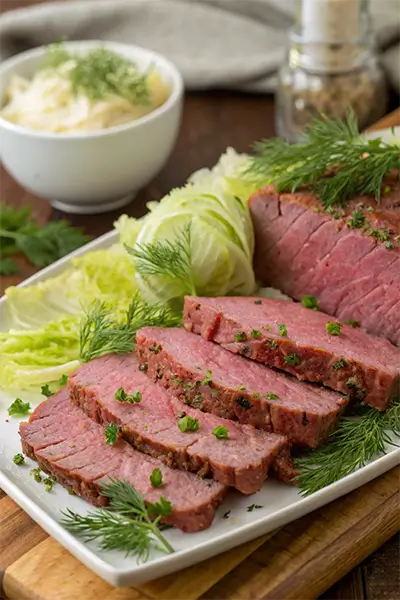
- Classic Pairings: Serve it with boiled cabbage, carrots, and potatoes for a traditional meal.
- Sandwiches: Thinly slice the meat and layer it on rye bread with sauerkraut and Swiss cheese for a Reuben sandwich.
- Hash: Use leftovers to make a hearty breakfast hash with potatoes and onions.
- Creative Plating: Serve it on a bed of sautéed greens or alongside roasted vegetables for a modern twist.
Preserving and Reheating Corned Beef: Quick Tips
Once you’ve made a delicious batch of corned beef, you’ll want to keep it fresh and flavorful for future meals. Here’s how to store and reheat it properly without losing its tenderness or taste.
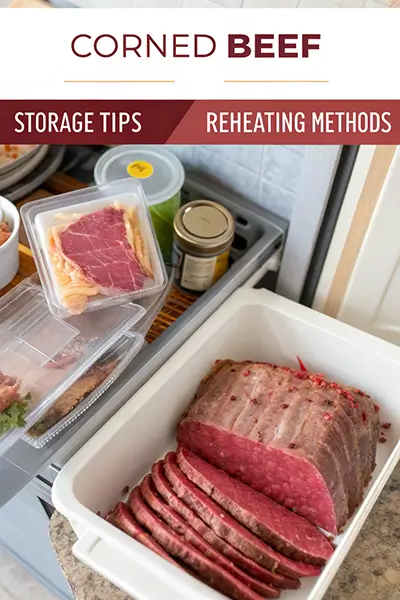
Preserving Corned Beef
- Refrigeration:
- Let the cooked corned beef cool to room temperature (no more than 2 hours to avoid bacteria growth).
- Wrap it tightly in plastic wrap or aluminum foil, or place it in an airtight container.
- Store in the refrigerator for 3 to 4 days.
- Freezing:
- For longer storage, wrap the corned beef tightly in plastic wrap, then place it in a freezer-safe bag or container.
- Label it with the date and freeze for up to 2 to 3 months.
- Pro Tip: Slice the corned beef before freezing for easier portioning and reheating.
Reheating Corned Beef
To keep your corned beef moist and flavorful, follow these reheating methods:
- Stovetop:
- Slice the corned beef and place it in a skillet.
- Add a splash of broth, water, or beer to prevent drying out.
- Cover and heat on low for 5-10 minutes, flipping occasionally.
- Oven:
- Preheat the oven to 325°F (160°C).
- Wrap the corned beef in aluminum foil with a splash of liquid (broth or water).
- Heat for 20-30 minutes, or until warmed through.
- Microwave:
- Place slices on a microwave-safe plate and cover with a damp paper towel.
- Heat on medium power in 30-second intervals, checking to avoid overcooking.
- Air Fryer:
- Preheat the air fryer to 300°F (150°C).
- Place the corned beef in the basket and heat for 5-7 minutes for a crispy edge.
Tips for Success
- Always add a bit of liquid (broth, water, or beer) when reheating to keep the meat moist.
- Avoid overheating, as it can dry out the meat.
- Slice the corned beef against the grain before reheating for the best texture.
By following these simple steps, you can enjoy your homemade corned beef just as much the second time around!
Conclusion
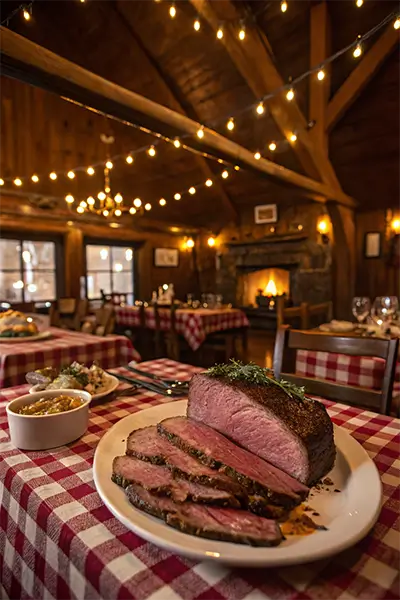
Making corned beef at home is a rewarding experience that connects you to culinary traditions while allowing you to put your own spin on it. From the brining process to the final slice, every step is an opportunity to create something special. Whether you’re serving it to family or friends, homemade corned beef is sure to impress. So, gather your ingredients, roll up your sleeves, and enjoy the process of creating a dish that’s as flavorful as it is meaningful.
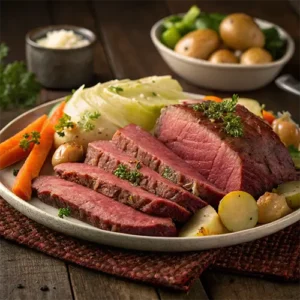
corned beef
Equipment
- 1 Large Pot For boiling the brisket.
- 1 Non-reactive container For brining the brisket.
Ingredients
Essential Ingredients
- 3-5 pounds beef brisket Choose a well-marbled cut.
- 1 cup kosher salt Crucial for the brining process.
- 1/2 cup sugar Brown sugar works best.
- 2 tablespoons pickling spices Blend of spices for flavor.
- 4 cloves garlic, minced Adds depth to the brine.
- 2 leaves bay leaves Contributes earthiness.
- 1 tablespoon black peppercorns Adds spice and aids curing.
- enough water water To cover the brisket.
Instructions
Gather Your Ingredients
- Start by collecting all the necessary ingredients. You will need: beef brisket, kosher salt, sugar, pickling spices, garlic, bay leaves, black peppercorns, and water.
Prepare the Brine
- In a large pot, combine kosher salt, sugar, pickling spices, minced garlic, bay leaves, and black peppercorns. Add about 4 cups of water and bring it to a boil. Stir until the salt and sugar dissolve completely.
Cool the Brine
- Remove the brine from heat and let it cool completely.
Brine the Brisket
- Place the brisket in a large, non-reactive container. Pour the cooled brine over the brisket, ensuring it is fully submerged. Cover the container and refrigerate for 5-7 days, flipping the brisket every couple of days.
Rinse and Prepare for Cooking
- After brining, remove the brisket from the brine and rinse it under cold water. Pat it dry with paper towels.
Cook the Corned Beef
- Place the brisket in a large pot and cover it with fresh water. Bring it to a boil, then reduce to a simmer. Cook for about 2.5 to 3 hours, or until tender.
Rest and Slice
- Once cooked, let the corned beef rest for about 15 minutes before slicing against the grain.
Video
____________________
You can visit our breakfast , lunch or dinner recipes from here :
Breakfast, Lunch, Dinner
FAQs
1. What is corned beef made of?
Corned beef is traditionally made from beef brisket, a cut of meat known for its rich flavor and tenderness. The brisket is cured in a brine solution made with kosher salt, sugar, and a blend of pickling spices, which typically include coriander, mustard seeds, allspice, and bay leaves. Garlic and peppercorns are often added for extra flavor. The brining process can take several days, allowing the meat to absorb the flavors and become tender.
2. How long does it take to cook corned beef?
The cooking time depends on the method you choose:
Stovetop: Simmering a 3 to 4-pound brisket takes about 2.5 to 3 hours.
Slow Cooker: Cooking on low heat takes approximately 8 to 10 hours.
Oven: Roasting at 325°F (160°C) takes about 3 to 4 hours.
Always check for doneness by ensuring the internal temperature reaches at least 190°F (88°C) for optimal tenderness.
3. Can I make corned beef without pickling spices?
Yes, you can! If you don’t have pickling spices on hand, you can create your own blend using common pantry ingredients. A simple mix might include:
1 tablespoon black peppercorns
1 tablespoon mustard seeds
1 teaspoon coriander seeds
1 teaspoon allspice berries
2 bay leaves
Feel free to experiment with other spices like cloves, cinnamon, or red pepper flakes to customize the flavor to your liking.
4. How do I store leftover corned beef?
To keep your leftovers fresh:
Refrigeration: Wrap the cooked meat tightly in plastic wrap or aluminum foil and store it in an airtight container. It will stay fresh for 3 to 4 days.
Freezing: For longer storage, wrap the meat tightly and place it in a freezer-safe bag or container. It can be frozen for up to 2 to 3 months. Slice it before freezing for easier reheating.
Always let the meat cool to room temperature before storing, and avoid leaving it out for more than 2 hours to prevent bacterial growth.
5. What are good side dishes for corned beef?
Corned beef pairs beautifully with a variety of sides. Here are some ideas:
Traditional: Boiled cabbage, carrots, and potatoes are classic accompaniments.
Irish-Inspired: Serve it with colcannon (mashed potatoes mixed with cabbage or kale) or Irish soda bread.
Sandwiches: Use thinly sliced corned beef to make Reuben sandwiches with rye bread, sauerkraut, Swiss cheese, and Thousand Island dressing.
Breakfast: Turn leftovers into a hearty hash with diced potatoes, onions, and bell peppers.
Modern Twists: Pair it with roasted Brussels sprouts, parsnips, or a fresh green salad for a lighter option.
6. Can I use a different cut of beef instead of brisket?
While brisket is the traditional cut for corned beef, you can use other cuts like round or rump roast. However, keep in mind that these cuts are leaner and may not be as tender as brisket. To compensate, you can brine them for a shorter time or cook them using a slow, moist-heat method to prevent dryness.
7. How do I know when the corned beef is done cooking?
The best way to check for doneness is by using a meat thermometer. The internal temperature should reach at least 190°F (88°C) for the meat to be tender. Additionally, you can test it by inserting a fork into the thickest part of the brisket. If it slides in easily and the meat pulls apart with little resistance, it’s ready.
8. Can I make corned beef in advance?
Absolutely! In fact, making it in advance can enhance the flavors. You can brine the brisket up to a week ahead of time and store it in the refrigerator until you’re ready to cook. Once cooked, the meat can be refrigerated for a few days or frozen for longer storage, making it a great option for meal prep or entertaining.
9. What’s the best way to reheat corned beef without drying it out?
To reheat leftovers while keeping them moist:
Oven: Wrap the meat in aluminum foil and heat at 325°F (160°C) for 20-30 minutes.
Stovetop: Slice the meat and simmer it in a bit of broth or water for 5-10 minutes.
Microwave: Place the meat on a microwave-safe plate, cover it with a damp paper towel, and heat on medium power in short intervals.
Adding a splash of broth, water, or even beer during reheating can help retain moisture.
10. Is corned beef healthy?
Corned beef can be part of a balanced diet when enjoyed in moderation. It’s a good source of protein, iron, and vitamin B12. However, it can be high in sodium due to the brining process. To make it healthier, you can reduce the salt in the brine or rinse the meat thoroughly before cooking. Pairing it with nutrient-rich sides like vegetables can also balance the meal.

